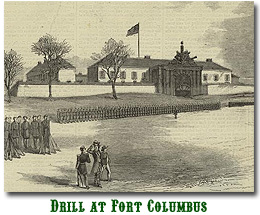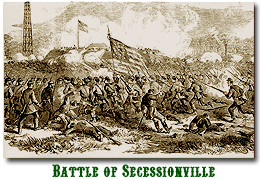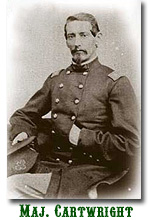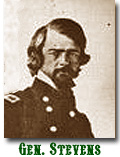Regimental
History: 1862
 s
the 28th Massachusetts concluded its
initial training at Camp Cameron in January, Col. Monteith and his
assembled men received their first flags – national and state
regimental colors – at a stirring ceremony presided over by
Gov. Andrew, Boston Mayor Joseph Wightman, and members of the Boston
City Council. Eight days later, the 28th received a third flag,
featuring patriotic and Irish slogans and symbolism on a field of
green, that Col. Monteith decided the unit would carry in place of the
standard-issue state flag carried by other Massachusetts volunteer
regiments.
s
the 28th Massachusetts concluded its
initial training at Camp Cameron in January, Col. Monteith and his
assembled men received their first flags – national and state
regimental colors – at a stirring ceremony presided over by
Gov. Andrew, Boston Mayor Joseph Wightman, and members of the Boston
City Council. Eight days later, the 28th received a third flag,
featuring patriotic and Irish slogans and symbolism on a field of
green, that Col. Monteith decided the unit would carry in place of the
standard-issue state flag carried by other Massachusetts volunteer
regiments.
 Leaving Boston, the regiment traveled
first to New York harbor for an additional month of drill and training
at Fort Columbus on Governor’s Island. From there, the 28th
embarked on February 14 for Hilton Head, South Carolina, where it
joined Gen. T.W. Sherman's Expeditionary Corps on February 23.
Leaving Boston, the regiment traveled
first to New York harbor for an additional month of drill and training
at Fort Columbus on Governor’s Island. From there, the 28th
embarked on February 14 for Hilton Head, South Carolina, where it
joined Gen. T.W. Sherman's Expeditionary Corps on February 23.
The 28th Massachusetts moved on April 7 to a
position on Daufuskie Island, opposite Fort Pulaski, to serve by
detachments in support of siege operations for the next two months.
Cos. A and K were sent to Jones and Bird Islands from April 18 to May
6. Six days after they returned to Daufuskie, Cos. A, C, D, F, and K
were moved to Tybee Island, Georgia, and remained detached from the
regiment for about two and a half weeks.
While away from the main body of the 28th,
the men of these detached companies had their hands full establishing a
formidable series of artillery positions, laying platforms of plank and
long timbers, and then hauling the heavy guns by hand from nearby flat
boats. They worked chiefly at night to avoid enemy fire. It was hard
and perilous work, as the men were often up to their middles in water
and ordered to move quietly.
The islands were largely composed of marshy
ground; so soft that a man could easily sink out of sight and either
drown or suffocate. There were mosquitoes and rank mud everywhere,
accidents and injuries were common, and soon dozens of soldiers who had
been hurt or fallen ill with malaria or other maladies were in army
hospitals instead of with the regiment. At least 22 died of disease
before the end of July, and many others were so weakened that they
would be discharged from service in the months ahead.
On May 30, the 28th Massachusetts was sent
to James Island as part of the Col. William Fenton's 1st Brigade of
Maj. Gen. Isaac Stevens' Division. Numbering some 520 men of all ranks,
the regiment came under hostile fire for the first time during
skirmishes on June 1 and 2, losing five men wounded.
 More severe combat lay ahead for the 28th
in the June 16 assault on Fort Johnson, known as the Battle of
Secessionville. Bogged down in an impassable swamp during the charge,
the regiment suffered 67 casualties, including Sgt. John J. McDonald,
who was killed carrying the colors. Returning to Hilton Head after this
inconclusive engagement, the Irish were commended for their poise and
bravery under fire.
More severe combat lay ahead for the 28th
in the June 16 assault on Fort Johnson, known as the Battle of
Secessionville. Bogged down in an impassable swamp during the charge,
the regiment suffered 67 casualties, including Sgt. John J. McDonald,
who was killed carrying the colors. Returning to Hilton Head after this
inconclusive engagement, the Irish were commended for their poise and
bravery under fire.
The 28th Massachusetts performed well during
its first several months in the field despite internal dissension and
inadequate leadership. Part of the problem was an ongoing conflict
between two Irish factions: Col. Monteith’s New Yorkers and
locals from Boston. Beyond that, even though the regiment was touted as
an ethnic unit, it was never 100 percent Irish, so there was also
tension between the immigrant and American-born soldiers in its ranks.
On May 20, Monteith was separated from his
command for “excessive drinking and numerous violations of
army regulations.” Placed under arrest by Gen. David Hunter,
Monteith resigned effective August 3, was court-martialed at Newport
News, Virginia, and on August 12, was discharged from the army.
 Gov.
Andrew named Lt. Col. MacLelland Moore to replace Monteith, but it
wasn’t long before Moore resigned, too, unable to cope with
his feuding officers. At that point, command of the regiment fell
temporarily to Maj. George W. Cartwright, a capable officer who would
serve in the 28th for another two years.
Gov.
Andrew named Lt. Col. MacLelland Moore to replace Monteith, but it
wasn’t long before Moore resigned, too, unable to cope with
his feuding officers. At that point, command of the regiment fell
temporarily to Maj. George W. Cartwright, a capable officer who would
serve in the 28th for another two years.
Even before this, Gen. Isaac Stevens tried
to persuade Gov. Andrew to appoint Stevens’ son to command
the 28th Massachusetts, arguing that an American was needed to exercise
proper control over an Irish regiment. But the question of permanent
leadership would be answered definitively before the end of the year,
with a smart but controversial choice.
Meanwhile, the regiment was on the move. On
July 16, the 28th Massachusetts left South Carolina and proceeded via
water transports back to Virginia, landing at Newport News two days
later. On July 20, the Irishmen were re-designated as part of the newly
formed 9th Corps under the overall command of Maj. Gen. Ambrose
Burnside. On August 3, the men of the 28th were transported to Aquia
Creek. From there, they proceeded to Fredericksburg and established
camp on August 6.
With Maj. Gen. John Pope's Army of Virginia
facing the threat of Lee's combined Confederate forces to the east, the
9th Corps was ordered to march through northern Virginia, finally
joining Pope's army in its fallback position along the Rappahannock
River near Bealton. In the days that followed, the 28th Massachusetts
marched and counter-marched until arriving at Centerville, where it
remained through August 29 in support of an artillery battery.
The next day, the Irishmen were placed in
the line of battle along the federal right flank and participated in
the Battle of Second Bull Run. Through the confusing action that
followed, the 28th was heavily engaged in the Union attack on
Confederate positions, and later came under heavy musket and artillery
fire while providing battery support.
By day's end, the regiment was in retreat
with the rest of the Union army, having suffered 135 casualties,
including Lt. William Flynn, who was killed, and now Lt. Col.
Cartwright, wounded. Command of the 28th Massachusetts passed to Capt.
Andrew Caraher of Co. A, who would lead the regiment for several months
and earn a promotion to major.
On September 1, with the right flank and
rear of the Union army facing the imminent threat of being turned by
Maj. Gen. Stonewall Jackson's Confederate forces at Chantilly, the 28th
Massachusetts was again ordered into the fight. Against enormous odds,
the Irishmen joined the Cameron Highlanders of the 79th New York in a
desperate charge across a cornfield.
 About two-thirds of the way, Hay's and
Field's concealed rebel brigades fired shattering volleys from the
woods ahead. The Irish and Scots staggered, wavered, and then let go a
cheer as Gen. Isaac Stevens rode to the front and urged them forward
just as the skies opened up with a blinding thunderstorm.
About two-thirds of the way, Hay's and
Field's concealed rebel brigades fired shattering volleys from the
woods ahead. The Irish and Scots staggered, wavered, and then let go a
cheer as Gen. Isaac Stevens rode to the front and urged them forward
just as the skies opened up with a blinding thunderstorm.
Within minutes, the rain had turned the
cornfield into a quagmire and many men could no longer fire their wet
rifles. Despite the drenching
storm and hail of
bullets, the renewed Union attack carried forward, with confused
hand-to-hand fighting taking place in the dark woods. Just as the rebel
front line gave way, Gen. Stevens fell from his mount, killed instantly
by a bullet through the head.
Disheartened, low on ammunition, and facing
heavy Confederate reinforcements, the 28th Massachusetts withdrew from
the isolated foothold it had won. That night, another 99 men failed to
answer the roll call, including the mortally wounded Lt. Alexander
Barrett.
In the days that followed, the 9th Corps
joined in the retreat back toward Washington and Pope's army was
absorbed into the Army of the Potomac, now again under the overall
command of Maj. Gen. George McClellan.
Continued
>

